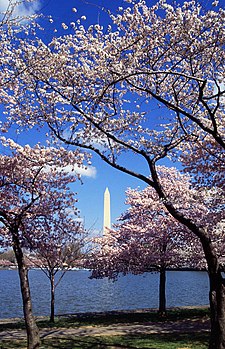West Potomac Park

1 Lincoln Memorial
2 Reflection Basin
3 Second World War Memorial (still under construction on the picture, but now completed)
4 Washington Monument (the area does not belong to the West Potomac Park)
5 Korean War Veterans Memorial
6 District of Columbia War Memorial (honoring World War I soldiers )
7 Franklin Delano Roosevelt Memorial
8 Jefferson Memorial
The West Potomac Park is a park in Washington, DC , bordering the National Mall . It includes the grounds south of the Lincoln Memorial Line , Reflection Pool, and Washington Monument . The park is home to many landmarks and monuments of national importance , including the Korean War Veterans Memorial , Jefferson Memorial , Franklin Delano Roosevelt Memorial, and the Martin Luther King, Jr. National Memorial . It is home to the Tidal Basin, an artificial bay of the Potomac River that was created in the 19th century and connects it to the northern end of the Washington Channel . It is administered by the National Park Service .
Cherry trees
Washington's famous cherry blossoms line the Tidal Basin and are the main attraction of the Spring National Cherry Blossom Festival. After a visit to the Japanese Empire, Eliza Ruhamah Scidmore was the first to have the idea of planting cherry trees in Washington. In 1885 she turned to the then superintendent for public buildings and land, Colonel Spencer Cosby, who rejected her idea. For the next 24 years she approached every new superintendent, without success. In 1906, David Fairchild, a botanist who worked for the United States Department of Agriculture, imported 75 flowering cherry trees from the Yokohama Nursery Company in Japan. Fairchild planted these trees on a hill on his property in Chevy Chase , Maryland to test their hardiness. Enthusiastic about the development of the trees, Fairchild and his wife began touting the Japanese cherry in 1907 as the ideal tree for planting along Washington Avenue.
In 1908, Fairchild gave cherry tree seedlings to students in the district to be planted on school grounds on Arbor Day . In his speech that day, in the presence of Eliza Scidmore, he explained his plan to make the "Speedway" (today's Corridor of Independence Avenue in West Potomac Park) an "Area of Cherries". In 1909, Scidmore decided to collect for the trees in order to donate them to the city. Scidmore sent this reflection to the new First Lady Helen Taft - wife of President William Howard Taft - who had lived in Japan and was familiar with the beauty of the cherry trees in bloom. She liked the idea, but preferred an avenue through what is now the park, as the rest of the area is too rough for planting. On April 13, 1909, at the request of the First Lady, the Superintendent for Public Buildings and Facilities ordered 90 Pennsylvania-grown cherry trees that were planted on the banks of the Potomac south of the Jefferson Memorial and have since disappeared.
On April 8, 1909, the Japanese chemist Jōkichi Takamine visited Mizuno Washington with the Japanese consul in New York City and learned of the plan to plant cherry trees. Takamine and Mizuno met with Helen Taft, and Takamine offered a donation of approximately 2,000 trees on behalf of the capital, Tokyo, which the capital accepted. The trees arrived in Seattle on December 10 , 1910 in the capital. An investigation team from the Department of Agriculture found that the trees were infested with insects , roundworms and plant diseases ; they were burned to protect the American flora with the consent of President Taft, and diplomatic correspondence calmed the situation. Various Japanese officials, including Tokyo Mayor Ozaki Yukio , suggested a second donation.
With the approval of the city council, sprouts of twelve species for 3,020 trees were taken from a famous collection on the banks of the Arakawa in Adachi in December 1910 , shipped in February 1912 and received in Washington on March 26, 1912. The next day, Helen Taft and the wife of the Japanese ambassador planted the first two trees west of the John Paul Jones Memorial ; the other trees were planted around the Tidal Basin and partly in East Potomac Park until 1920 . The annual cherry blossom festival has been held since 1935 on the initiative of various civil society organizations. Four trees were felled in December 1941, presumably in revenge for the Japanese attack on Pearl Harbor ; In 1952, offspring from Washington were sent to Tokyo to restore the Arakawa Bank collection from which the Washington specimens came and which had been neglected during World War II. In 1965, the Japanese government donated an additional 3,800 cherry trees to the United States, two of which were planted by the first lady, Lady Bird Johnson , and the wife of the Japanese ambassador. Further replanting followed, including 1999 shoots of the more than 1400 year old Usuzumi cherry tree .
Web links
- National Cherry Blossom Festival (English)
- Detailed plan of the park (PDF, English)
supporting documents
- ↑ The following remarks are based on History of the Cherry Trees. In: NPS.gov (English).
Coordinates: 38 ° 53 '4.9 " N , 77 ° 2' 20.8" W.
